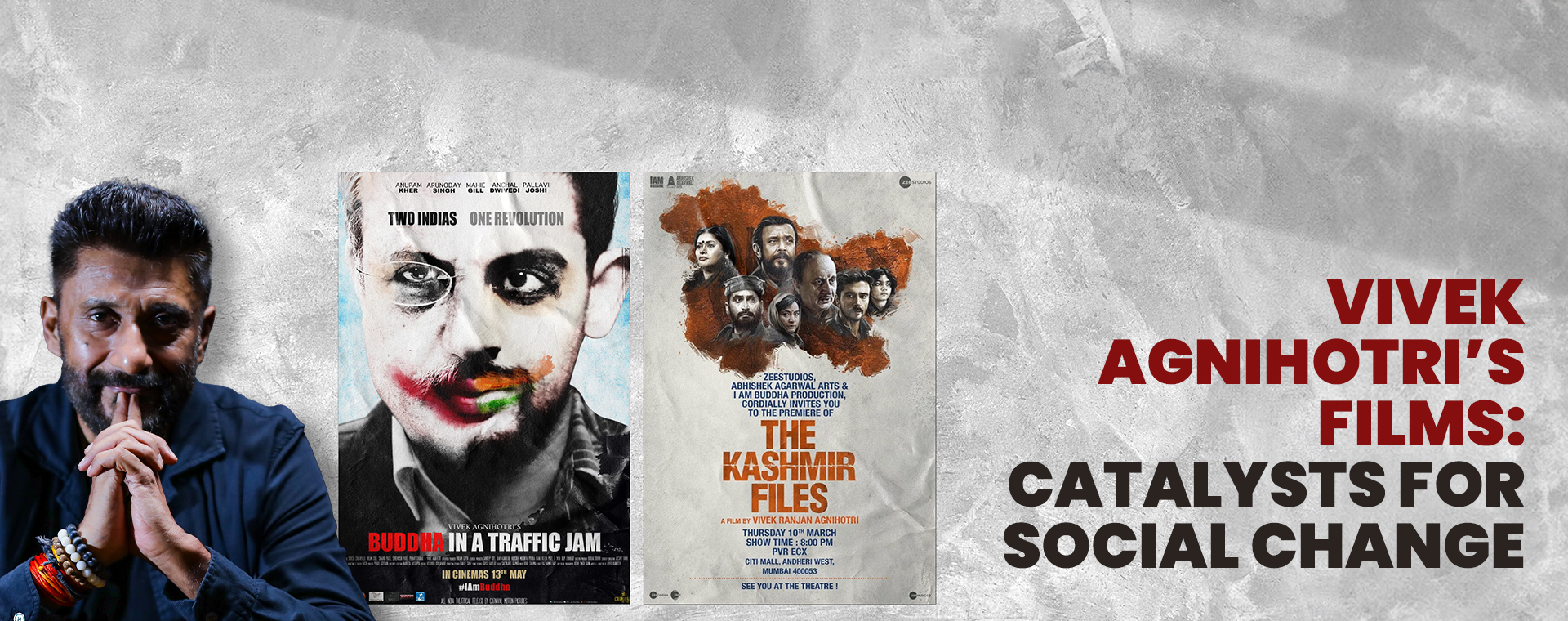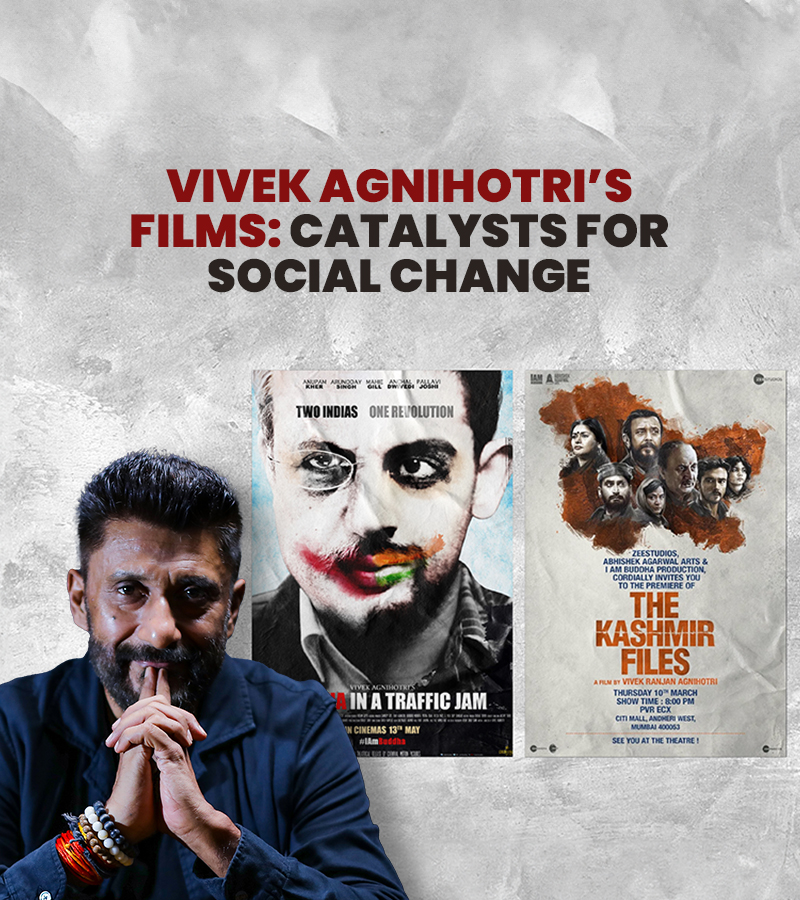

Can Films Start Social Movements and Change Society? Yes, They Can.
Films are not only a means of entertainment. Find out how Vivek Agnihotri has been using them to spark conversations and change society.
Films are not just a medium for storytelling and entertainment, but also a catalyst for social change. Throughout history, filmmakers have used the transformative power of cinema to spark conversations, challenge perspectives, and ignite movements that reshape our world.
In this blog, we dive into the power of films, especially those by Vivek Ranjan Agnihotri, as a tool for activism, exploring how they raise awareness, inspire empathy, and motivate action.
The Catalytic Power of Film
Films can transport audiences into different realities, fostering a sense of connection and understanding of experiences far removed from the daily reality.
Here’s how films drive social change:
Raising Awareness: Films can bring to light hidden realities, exposing social injustices, environmental concerns, and human rights violations. Shedding light on these issues, they spark conversation and ignite a sense of urgency.
Films, by allowing us to step into the shoes of characters facing struggles different from our own, foster empathy and compassion. This shared humanity and responsibility create a sense of connection and understanding.
Powerful films don’t just stop at raising awareness and fostering empathy. They have the potential to inspire action, motivating audiences to get involved, volunteer their time, donate to causes, or even take to the streets in protest. This empowerment and engagement are the true power of films.
Agnihotri’s Films: A Weapon for Social Change
Vivek Ranjan Agnihotri, a renowned Indian filmmaker, is a prime example of using cinema as a tool for activism. His films are not mere entertainment but meticulously crafted social commentaries that spark national conversations and inspire action.
Let’s explore some of Agnihotri’s most impactful works:
The Kashmir Files (2022): This controversial yet thought-provoking film delves into the horrific experiences of Kashmiri Pandits during the 1990s insurgency. The Kashmir Files doesn’t shy away from depicting the brutality and displacement faced by this community, sparking national conversations about religious persecution and the importance of remembering forgotten tragedies.
Buddha in a Traffic Jam (2016): This satirical film tackles the corruption issue in India, exposing the systemic rot that plagues everyday life. Through a dark comedic lens, Buddha in a Traffic Jam compels viewers to confront uncomfortable truths and question the status quo.
These are just a few examples of how Agnihotri’s films use the power of storytelling to raise awareness, challenge perspectives, and inspire social change.
Beyond Entertainment: The Impact of Activist Films
The impact of films like Agnihotri’s extends far beyond the silver screen. Here are some real-world consequences:
Policy Changes: Activist films can influence policy changes. For instance, The Kashmir Files is believed to have played a role in the Indian government’s decision to offer additional support to Kashmiri Pandit refugees.
Social Movements: Films can act as catalysts for social movements. Powerful documentaries like Blackfish (2013) are credited with raising awareness about animal cruelty in captivity, leading to changes in the treatment of orcas at marine parks.
Shifting Public Opinion: Films can shift public opinion on critical issues by fostering empathy and understanding. Movies like Schindler’s List (1993) are believed to have played a role in raising awareness about the Holocaust.
These are just a few examples of the far-reaching impact that activist films can have.
The Future of Film as a Tool for Activism
As filmmaking technology becomes more accessible and audiences become more engaged with social issues, the role of film as a tool for activism is poised to grow even stronger.
Here are some exciting possibilities:
The rise of independent filmmakers, with their unique perspectives and lower production costs, is likely to play a significant role in creating socially conscious content that can drive social change.
Interactive Cinema: The rise of interactive storytelling platforms could allow audiences to engage more actively with the issues presented in films, potentially leading to real-world action.
Global Reach: With the rise of streaming platforms, films can reach wider audiences than ever, sparking global conversations and movements.
The future of film as a tool for activism is bright. As storytellers continue to push boundaries and audiences become more aware, films have the potential to become even more powerful agents for social change.
Be the Change
Film is a powerful tool for social change. It can educate, inspire, and mobilize audiences in ways few other mediums can.
What You Can Do
Inspired by the power of activist films? Here are some ways you can be a part of the movement:
Support Activist Filmmakers: Seek out and watch films that tackle critical social issues. Share them with friends and family, sparking conversations and raising awareness.
Become an Informed Citizen: Don’t rely solely on films for information. Conduct your own research to gain a deeper understanding of the issues presented.
Raise Your Voice: Speak out about the issues that matter to you. Write to your local representatives, attend protests, or volunteer your time to organizations working for change.
Embrace the Power of Storytelling: Consider using your voice to create change. You could write, make videos, or even organize community events. Share your stories and perspectives to raise awareness and inspire others. By taking big and small actions, we can all harness the power of film and storytelling to create a more just and equitable world.
The Final Reel
Films are not just entertainment; they are powerful tools for social change. By raising awareness, fostering empathy, and inspiring action, they have the potential to shape our world for the better. The next time you watch a film, consider the message it conveys. Could it be a catalyst for change? Let’s all strive to actively participate in the stories we consume, using the power of film to create a brighter future.






